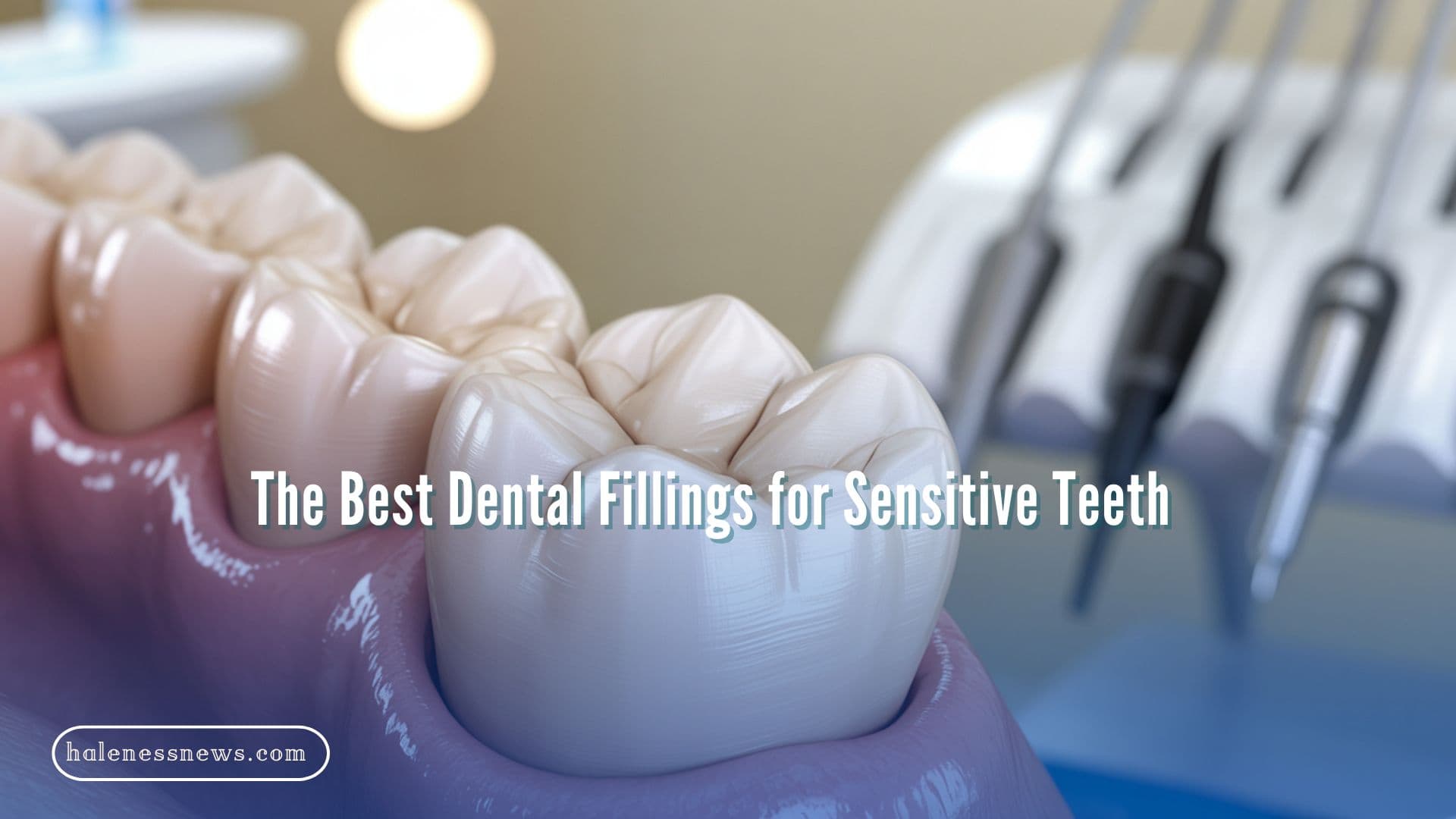Sensitive teeth can be a real discomfort, especially when you’re dealing with cavities that require filling. The pain of a sensitive tooth is often triggered by temperature changes, sugary foods, or even brushing. But finding the right dental filling material for sensitive teeth can make a huge difference in comfort and long-term dental health.
In this article, we will explore the best dental fillings for sensitive teeth, how they work, and which option might be the best for you. Whether you’re dealing with a minor cavity or something more serious, we’ll break it down for you in simple terms, highlighting the pros and cons of each type of filling.
What Causes Sensitive Teeth?
To understand which filling material works best for sensitive teeth, it’s important to first understand what causes tooth sensitivity. Teeth sensitivity often occurs when the protective enamel on the tooth wears down, exposing the underlying layer called dentin. Dentin contains tiny tubules that lead to nerve endings, which is why even slight changes in temperature, pressure, or sweetness can cause discomfort.
Fillings are used to restore teeth after a cavity has formed, but the material used can affect how sensitive your teeth feel afterward. Some fillings are better suited for sensitive teeth than others, providing better protection and reducing discomfort.
Types of Dental Fillings for Sensitive Teeth:
When choosing a dental filling for sensitive teeth, the material plays a crucial role in your comfort. Here are some of the most popular filling materials and how they compare in terms of sensitivity management, durability, and appearance.
1. Composite Resin Fillings (Tooth-Colored Fillings)
Composite resin fillings are one of the most common materials used for fillings, especially for visible teeth. These fillings are made of a mixture of plastic and fine glass particles, which can be molded to the shape of the cavity. They are a great choice for people who are concerned about the aesthetic appearance of their teeth, as the resin can be color-matched to your natural tooth shade.
- Pros:
- Aesthetic Appeal: They blend seamlessly with the natural tooth, making them ideal for visible areas.
- Gentle on Sensitive Teeth: Composite resins don’t expand or contract significantly with temperature changes, which can help reduce sensitivity.
- Less Drilling Required: These fillings bond directly to the tooth, meaning less tooth structure needs to be removed.
- Cons:
- Durability: Composite resins are less durable than other filling materials like gold or amalgam. Over time, they may wear down, especially in areas that experience heavy chewing pressure.
- Cost: They can be more expensive than amalgam fillings, though they may be covered by insurance.
2. Glass Ionomer Fillings
Glass ionomer fillings are made from a mixture of glass particles and an acrylic acid-based material. One of the standout benefits of glass ionomer fillings is that they release fluoride, which helps to protect the tooth from further decay and reduce sensitivity.
- Pros:
- Fluoride Release: This feature helps prevent further decay and strengthens the surrounding tooth structure.
- Suitable for Sensitive Teeth: Glass ionomer fillings are generally less likely to cause temperature sensitivity compared to metal-based fillings.
- Good for Non-Visible Areas: Glass ionomer is often used in areas that aren’t highly visible, such as near the gum line or on baby teeth.
- Cons:
- Shorter Lifespan: Glass ionomer fillings are not as durable as composite resins or amalgams and may need to be replaced sooner.
- Less Aesthetic: They are not as natural-looking as composite resin fillings and may appear dull or opaque.
3. Porcelain Fillings (Inlays and Onlays)
Porcelain fillings, also known as inlays or onlays, are custom-made to fit the cavity perfectly. Porcelain is durable, and its aesthetic qualities make it a popular choice for fillings in visible areas of the mouth.
- Pros:
- Durability: Porcelain fillings are highly durable and resistant to staining and wear.
- Natural Appearance: They match the color of your natural teeth, making them an excellent choice for cavities in visible areas.
- Reduces Sensitivity: The material fits tightly and seals the tooth well, which can help protect it from temperature changes that trigger sensitivity.
- Cons:
- Cost: Porcelain fillings tend to be more expensive than other types of fillings.
- Multiple Visits Required: Unlike composite resin, porcelain fillings typically require two visits to the dentist: one to create an impression and another to place the filling.
4. Silver Fillings (Amalgam)
Amalgam fillings, made of a mixture of silver, mercury, tin, and copper, are some of the oldest and most durable dental filling materials. Although they are not typically used for aesthetic purposes due to their metallic color, they are highly effective for larger fillings in areas where appearance is less of a concern.
- Pros:
- Durability: Amalgam is one of the most durable filling materials, especially for large cavities in the back teeth.
- Cost-Effective: It’s one of the least expensive filling options.
- Strong Seal: Amalgam fills cavities tightly, preventing further decay.
- Cons:
- Appearance: The silver color makes them highly visible, which can be a downside for people with cavities in visible areas.
- Temperature Sensitivity: The material can expand and contract with temperature changes, which may increase sensitivity in some people.
- Mercury Concerns: While the mercury in amalgam fillings is considered safe by many health organizations, some patients prefer to avoid it.
5. Resin Ionomer Fillings
Resin ionomer fillings are similar to glass ionomer fillings, but they are made with additional resin for enhanced durability. These fillings are often used for cavities in areas that don’t experience heavy chewing pressure.
- Pros:
- Fluoride Release: Like glass ionomer, resin ionomer fillings release fluoride, which helps prevent decay.
- Lower Sensitivity: These fillings help seal the cavity and reduce temperature sensitivity.
- Cons:
- Less Durable: They are not as strong as composite resins or amalgam and may need replacement sooner.
Cost Comparison of Different Dental Fillings:
Here’s a table outlining the approximate cost range of different types of dental fillings in the U.S. Keep in mind that costs can vary based on factors like your location, the size of the cavity, and your dental insurance coverage.
| Filling Type | Cost Range (Per Filling) | Factors Affecting Cost |
|---|---|---|
| Composite Resin | $150 – $450 | Tooth location (front teeth are often more expensive), size of the cavity, dentist’s experience |
| Glass Ionomer | $100 – $250 | Typically used for smaller cavities or temporary fillings |
| Porcelain | $500 – $2,500 (Inlays/Onlays) | Customization, complexity of the filling, and the number of visits required |
| Amalgam | $100 – $250 | Size of cavity, material costs, less expensive than porcelain and composite |
| Resin Ionomer | $150 – $300 | Similar to glass ionomer but more durable; often used in non-visible areas |
Important Notes:
- Insurance: Many dental insurance plans cover a portion of the cost for fillings, particularly for more affordable options like amalgam or composite resin. Check with your insurance provider for specifics.
- Location: Dental prices can vary widely based on geographic location. Larger cities or areas with higher living costs may have higher prices for dental procedures.
- Type of Tooth: Fillings for back teeth (molars) are often more expensive than those for front teeth, especially if they need a more durable material like porcelain or composite resin.
How to Choose the Best Dental Filling for Sensitive Teeth?
When selecting a filling for sensitive teeth, consider the following factors:
- Location of the Cavity: Fillings in visible areas should be aesthetic, so composite resin or porcelain may be best. For less visible areas, glass ionomer or amalgam could be suitable.
- Your Sensitivity Level: If you have severe sensitivity, it’s important to discuss this with your dentist. Composite resins and porcelain are gentle on sensitive teeth.
- Cost: Depending on your budget, you may need to choose a more affordable option like amalgam or glass ionomer.
- Durability: If you’re looking for something long-lasting, porcelain or amalgam fillings may be the right choice.
- Insurance Coverage: Some types of fillings may be partially covered by insurance, so it’s important to verify what’s covered.
Frequently Asked Questions:
1. What is the most painless filling for sensitive teeth?
Composite resin fillings are often considered the most comfortable for people with sensitive teeth. They bond directly to the tooth and cause minimal thermal sensitivity because they don’t expand or contract as much with temperature changes. Additionally, they require less drilling, which reduces discomfort during the procedure.
2. Do fillings permanently cure tooth sensitivity?
Fillings can greatly reduce or eliminate sensitivity caused by decay, but they may not always cure it permanently—especially if there are underlying issues like enamel erosion or gum recession. However, choosing the right filling material and practicing good oral hygiene can help maintain long-term comfort.
3. How can I reduce sensitivity after getting a dental filling?
You can reduce post-filling sensitivity by avoiding very hot or cold foods, using toothpaste designed for sensitive teeth (such as Sensodyne), and steering clear of acidic or sugary snacks. If sensitivity persists for more than a few weeks, consult your dentist for an evaluation.
4. Is it safe to have metal fillings if I have sensitive teeth?
Metal (amalgam) fillings are durable but can conduct heat and cold more than tooth-colored alternatives, which may increase sensitivity in some patients. If you’re concerned about this, discuss options like composite resin or glass ionomer with your dentist—they are often better suited for sensitive teeth.
Conclusion
The best dental filling for sensitive teeth depends on several factors, including the location of the cavity, your sensitivity level, and your aesthetic preferences. Composite resin and porcelain fillings are great choices for those looking for an aesthetic and comfortable solution, while amalgam and glass ionomer fillings offer durability and affordability for larger cavities.
Regardless of the material you choose, it’s important to consult with your dentist to make sure you’re selecting the best option for your unique needs. By taking care of your fillings and maintaining good oral hygiene, you can reduce tooth sensitivity and enjoy long-lasting comfort.
Latest Post:





